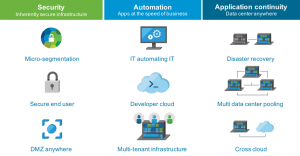Worth Reading: Why you should document first
The post Worth Reading: Why you should document first appeared first on rule 11 reader.
The post Worth Reading: Why you should document first appeared first on rule 11 reader.
Why are clouds not using cloud for power ?
The post Private Cloud Electricity – Owning Your Power Supplies appeared first on EtherealMind.
 The company is using machine learning to predict device behavior.
The company is using machine learning to predict device behavior.
 The company hints at plans to add Google Cloud platform into the mix.
The company hints at plans to add Google Cloud platform into the mix.
BGP Route reflector routing loop arise in IP networks. In this post, I will illustrate the topology which will loop the IP packets between the routers and I will describe multiple possible solution and share a best practice to design BGP Route Reflector in an IP network. BGP Route Reflector Routing loop […]
The post BGP Route Reflector routing loop problem ! appeared first on Cisco Network Design and Architecture | CCDE Bootcamp | orhanergun.net.
See how to set policies in Identity Services Engine for personal mobile devices on the network.
Just like with the other routing protocols such as OSPF or EIGRP, BGP speaking routers first need to become neighbors prior to
The post BGP LLDP Peer Discovery appeared first on Noction.
The popular TV show provides seven lessons for those who work to maintain the network.
Ansible is a 'radically simple', open source, IT automation platform. Architecture Control Node The Ansible control node is the central point of management for managed nodes. Configuration is pushed to the managed nodes from the control node. Managed Node A managed node...continue reading
Earlier today, Cloudflare terminated the account of the Daily Stormer. We've stopped proxying their traffic and stopped answering DNS requests for their sites. We've taken measures to ensure that they cannot sign up for Cloudflare's services ever again.
Our terms of service reserve the right for us to terminate users of our network at our sole discretion. The tipping point for us making this decision was that the team behind Daily Stormer made the claim that we were secretly supporters of their ideology.
Our team has been thorough and have had thoughtful discussions for years about what the right policy was on censoring. Like a lot of people, we’ve felt angry at these hateful people for a long time but we have followed the law and remained content neutral as a network. We could not remain neutral after these claims of secret support by Cloudflare.
Now, having made that decision, let me explain why it's so dangerous.
There are a number of different organizations that work in concert to bring you the Internet. They include:
This year at VMworld 2017 we have a great agenda full of highly technical sessions around NSX. Over the past few years NSX has expanded to meet a variety of use cases as our Content Catalog clearly shows. Based on the project your working on today, check out our recommendations for the best technical sessions for these specific NSX use cases:

General NSX Sessions:
TS7003KU: Transforming Networking and Security for the Digital Era
Speakers: Milin Desai, Tom Corn and 3 customers
At a time when changes to technology are coming at us at a fast pace, how do customers meet and exceed business expectations? This session will focus on how customers are on their SDDC journey in context of network and security. Through the lens of the customer we will share what drives adoption, technology updates, team dynamics and becoming part of the overall business success.
NET3282BU: The NSX Practical Path
Speakers: Nikhil Kelshikar, Ron Fuller
We will share how customers have found value with NSX by getting started with one of the use cases around Security, Automation or App continuity. We will show Continue reading
This is a case study which provides a detailed design steps for IGP protocol on hypothetical Internet Service Provider, called Ausnet. You can download the Case Study as PDF format from the below link by providing your name and email address.
The post IS-IS Case Study – Ausnet appeared first on Cisco Network Design and Architecture | CCDE Bootcamp | orhanergun.net.
The post Worth Reading: The shape of HPC and AI iron to come appeared first on rule 11 reader.